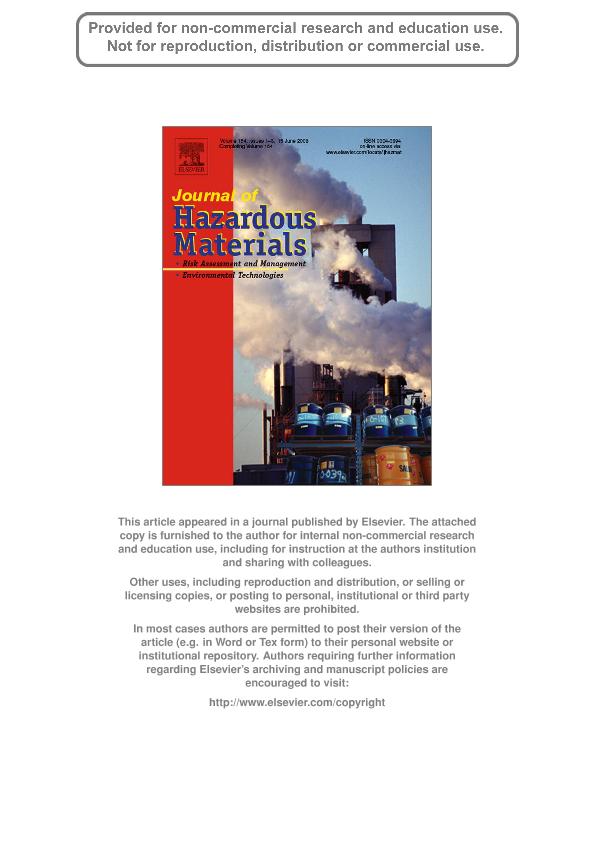Mostrar el registro sencillo del ítem
dc.contributor.author
Nievas El Makte, Marina Lucrecia

dc.contributor.author
Commendatore, Marta Graciela

dc.contributor.author
Esteves, Jose Luis

dc.contributor.author
Bucala, Veronica

dc.date.available
2018-10-16T19:15:56Z
dc.date.issued
2008-06
dc.identifier.citation
Nievas El Makte, Marina Lucrecia; Commendatore, Marta Graciela; Esteves, Jose Luis; Bucala, Veronica; Biodegradation pattern of hydrocarbons from a fuel oil-type complex residue by an emulsifier-producing microbial consortium; Elsevier Science; Journal of Hazardous Materials; 154; 1-3; 6-2008; 96-104
dc.identifier.issn
0304-3894
dc.identifier.uri
http://hdl.handle.net/11336/62463
dc.description.abstract
The biodegradation of a hazardous waste (bilge waste), a fuel oil-type complex residue from normal ship operations, was studied in a batch bioreactor using a microbial consortium in seawater medium. Experiments with initial concentrations of 0.18 and 0.53% (v/v) of bilge waste were carried out. In order to study the biodegradation kinetics, the mass of n-alkanes, resolved hydrocarbons and unresolved complex mixture (UCM) hydrocarbons were assessed by gas chromatography (GC). Emulsification was detected in both experiments, possibly linked to the n-alkanes depletion, with differences in emulsification start times and extents according to the initial hydrocarbon concentration. Both facts influenced the hydrocarbon biodegradation kinetics. A sequential biodegradation of n-alkanes and UMC was found for the higher hydrocarbon content. Being the former growth associated, while UCM biodegradation was a non-growing process showing enzymatic-type biodegradation kinetics. For the lower hydrocarbon concentration, simultaneous biodegradation of n-alkanes and UMC were found before emulsification. Nevertheless, certain UCM biodegradation was observed after the medium emulsification. According to the observed kinetics, three main types of hydrocarbons (n-alkanes, biodegradable UCM and recalcitrant UCM) were found adequate to represent the multicomponent substrate (bilge waste) for future modelling of the biodegradation process.
dc.format
application/pdf
dc.language.iso
eng
dc.publisher
Elsevier Science

dc.rights
info:eu-repo/semantics/openAccess
dc.rights.uri
https://creativecommons.org/licenses/by-nc-sa/2.5/ar/
dc.subject
Bilge Waste
dc.subject
Biodegradation
dc.subject
Emulsification
dc.subject
Fuel Oil Residue
dc.subject
Ucm
dc.subject.classification
Oceanografía, Hidrología, Recursos Hídricos

dc.subject.classification
Ciencias de la Tierra y relacionadas con el Medio Ambiente

dc.subject.classification
CIENCIAS NATURALES Y EXACTAS

dc.title
Biodegradation pattern of hydrocarbons from a fuel oil-type complex residue by an emulsifier-producing microbial consortium
dc.type
info:eu-repo/semantics/article
dc.type
info:ar-repo/semantics/artículo
dc.type
info:eu-repo/semantics/publishedVersion
dc.date.updated
2018-10-12T14:47:34Z
dc.journal.volume
154
dc.journal.number
1-3
dc.journal.pagination
96-104
dc.journal.pais
Países Bajos

dc.journal.ciudad
Amsterdam
dc.description.fil
Fil: Nievas El Makte, Marina Lucrecia. Consejo Nacional de Investigaciones Científicas y Técnicas. Centro Nacional Patagónico; Argentina
dc.description.fil
Fil: Commendatore, Marta Graciela. Consejo Nacional de Investigaciones Científicas y Técnicas. Centro Nacional Patagónico; Argentina
dc.description.fil
Fil: Esteves, Jose Luis. Consejo Nacional de Investigaciones Científicas y Técnicas. Centro Nacional Patagónico; Argentina
dc.description.fil
Fil: Bucala, Veronica. Universidad Nacional del Sur; Argentina. Consejo Nacional de Investigaciones Científicas y Técnicas; Argentina
dc.journal.title
Journal of Hazardous Materials

dc.relation.alternativeid
info:eu-repo/semantics/altIdentifier/doi/http://dx.doi.org/10.1016/j.jhazmat.2007.09.112
dc.relation.alternativeid
info:eu-repo/semantics/altIdentifier/url/https://www.sciencedirect.com/science/article/pii/S0304389407014033
Archivos asociados
